CONTROLS TECHNOLOGY | DALI supports standardized wireless lighting control architectures
Contemporary lighting technology has evolved compared to only a few years ago, featuring energy-saving LEDs and sophisticated control systems combined with sensors and IoT devices. This connected ecosystem creates opportunities for attractive, efficient lighting projects that can be controlled at the touch of a button or a smartphone’s screen, or even respond to the world around us.
Conventional lighting systems have been controlled using wired networks, but recently interest in wireless connectivity methods has increased. In fact, the global market for wireless smart lighting control systems is estimated to be around $6 billion, growing to nearly $19 billion by 2030, according to research firm Research and Markets.
Wireless control systems can be easier and quicker to install due to less wiring needed — particularly in older building retrofits, which may set restrictions on where wires can run. Quicker installation translates into lower labor costs.
The lack of wires can also make a system more flexible and scalable, with the freedom to move luminaires and add new devices.
Wireless lighting systems are typically organized in a mesh configuration, where each device or node is connected to multiple other nodes. This increases reliability, as there is no single point of failure, and control messages are automatically rerouted if one node fails.
However, there are still scenarios where a wired solution is preferred or even may be mandated. In some circumstances, hybrid solutions may be desirable. Some technologies enable choice and keep future options open by enabling wired and wireless lighting-control networks to operate together.
Interoperability with a standard protocol
Whether wired or wireless, a lighting control system requires each device to be capable of communicating with the others. Such interoperability can only be achieved with a suitable standard, which manufacturers all agree to follow.
In lighting control, the Digital Addressable Lighting Interface (DALI) is likely the most widely known open standardized protocol. It has been deployed in countless applications around the world over many years. Based on the open global standard IEC 62386, DALI is an established protocol for bidirectional digital communication between lighting control devices and sensors. DALI devices are individually addressable, so it fits well with other IoT systems.
DALI is managed by the DALI Alliance, an open consortium of lighting companies with more than 350 members globally. The alliance drives the growth of DALI-based solutions and operates the DALI-2 and D4i certification programs to ensure cross-vendor interoperability.
How DALI supports wireless lighting
Typically, DALI uses a dedicated two-wire bus for communications between devices. However, more recent developments offer two alternative approaches to combining DALI lighting control and wireless connectivity:
- Standardized gateways between DALI and wireless ecosystems – starting with specifications for Bluetooth mesh and Zigbee from the Connectivity Standards Alliance (CSA).
- DALI+, a new specification that supports using a wireless architecture instead of wires for a DALI system.
Both approaches have merits, and having two options gives designers the flexibility to choose the right control system for a specific application. A third option — the capability to combine wired and wireless devices in a system — further expands flexibility.
Wireless to DALI gateways
Wireless to DALI gateways enable existing wired DALI devices to be used in a non-DALI wireless ecosystem. The gateways translate commands from the wireless side so the wireless ecosystem can control and query the DALI devices as if they were part of the wireless network.
Figure 1 shows how a gateway participates in the wireless ecosystem. The gateway contains a DALI application controller that connects to devices in the wired DALI network. The gateway architecture enables the wireless ecosystem to control and query DALI control gear, such as LED drivers, as if the DALI devices were part of the wireless network.
DALI has specified two such gateways, with Bluetooth mesh and Zigbee as the wireless protocols, and other protocols may be supported in future. The DALI devices are automatically discovered and addressed by the gateway before joining the ecosystem network. Security is ensured via the existing features of Bluetooth mesh or Zigbee as appropriate. Readers can learn more about the inherent security capabilities from past LEDs Magazine articles on connected lighting networks and Bluetooth features.
In operation, the wireless devices talk to the gateway using their existing protocol (Zigbee or Bluetooth). They can control light output and fading of DALI devices via the gateway, and they can read lamp failure information from the DALI devices, as well as selected data such as energy usage and diagnostics.
Note that application controllers in the DALI network cannot control, configure, or query devices in the wireless ecosystem. This means that the wireless ecosystem is effectively the primary control and the DALI system is subordinate.
It might seem simpler to implement the entire network using Bluetooth mesh or Zigbee. However, one benefit of using the gateway specifications is that existing DALI products — especially LED drivers — can be used. The market has many DALI-2 and D4i certified products from a wide range of suppliers, providing choice and future-proofing.
Another reason to base a lighting control system around DALI is that the protocol was developed specifically for lighting and has tailored lighting-control features, as well as providing access to luminaire, energy, and diagnostics data. Other protocols cannot offer the same rich and broad set of standardized, lighting-specific features.
Figure 2 illustrates an example of gateway use in two scenarios. In the corridor, a single gateway allows the wireless ecosystem to control a wired network of DALI luminaires. In the office, each luminaire has an individual gateway that shares the wireless network with other wireless controllers and sensors.
What does DALI+ offer?
The second approach to wireless lighting control is DALI+, which uses DALI over wireless or internet protocol (IP)–based networks.
DALI+ devices communicate using existing DALI commands carried over a wireless or IP-based link, rather than the dedicated pair of wires used by DALI-2 and D4i.
DALI+ builds on the proven DALI lighting-control features in wired systems and offers access to the same data from control gear, luminaires, and sensors. All DALI control gear and control devices standardized under IEC 62386 can be implemented in DALI+, including LED drivers, color-controllable drivers, emergency drivers, application controllers, push buttons, and sensors.
In some systems, there may be a need to combine DALI+ and existing wired DALI systems or luminaires. The DALI commands and features are the same for DALI+ and wired DALI. A new type of device known as a bridge enables application controllers in the DALI+ network to access and control the DALI wired control gear and control devices (Fig. 3).
For more complex systems, a backbone such as Ethernet can be used to connect multiple wireless DALI+ systems. Additionally, DALI application controllers can support multiple subnets, which may comprise any combination of DALI+ and wired DALI subnets (Fig. 4).
Which network protocols can be employed?
Several wireless technologies can be used for lighting control. Typically, it makes sense to use a widely adopted standard to increase flexibility, avoid lock-in to one particular vendor, and leverage interoperable hardware devices from various suppliers.
The DALI Alliance has published two gateway specifications to cover wireless-to-DALI gateways with either Bluetooth mesh (Part 341) or Zigbee (Part 342). The same certified DALI-2 or D4i drivers can be used with either a Bluetooth mesh or a Zigbee gateway.
Initially, DALI+ supports Thread, an IP-based, low-power, wireless mesh networking protocol using 6LoWPAN wireless technology. Thread’s existing authentication and encryption methods ensure security, and the DALI+ lighting system can take advantage of other Thread features, such as self-healing and automatic configuration. DALI+ with Thread also allows the use of IPv6 addressing, which means the number of devices in a DALI+ system is virtually unlimited for all practical purposes.
Other Thread devices may be used in the same Thread network as the DALI+ devices, increasing flexibility for system designers to add non-DALI devices such as sensors or door access hardware. Thread border routers allow connection through other IP-based physical layers — for example, Ethernet or Wi-Fi — which supports highly scalable systems.
The use of an IP-based carrier, such as Thread, for DALI+ also opens the possibility to integrate the lighting system with other functions, such as HVAC or building access, via a building’s IT infrastructure.
Conclusions
DALI is the established standard for digital lighting-control systems, and the DALI Alliance now enables lighting system designers to work with wireless connectivity supported by proven technology and wide industry adoption. The DALI Alliance is developing robust certification programs for the new wireless approaches.
There are two distinct options for wireless: Wireless to DALI gateways allow existing DALI-wired products to be used in a non-DALI wireless system; and DALI+ enables devices to communicate using existing DALI commands, carried over a wireless or IP-based medium.
Whichever option best suits lighting designers, the addition of wireless to the familiar DALI standard extends choice and creative freedom. At the same time, it ensures designers can rely on rigorous standardization and certification, along with DALI’s lighting-specific capabilities, such as precise dimming and color control.
For offices, homes, factories, and other smart buildings, the combination of wireless and DALI brings unparalleled flexibility and control, along with a roadmap to add new standards and features in the future.
DALI is a registered trademark of the DALI Alliance.
PAUL DROSIHN is general manager of the DALI Alliance, the global industry organization for DALI (Digital Addressable Lighting Interface) protocol standardization and promulgation.
Follow our LinkedIn page for our latest news updates, contributed articles, and commentary, and our Facebook page for events announcements and more. You can also find us on the X platform.
Paul Drosihn
PAUL DROSIHN is general manager of the DALI Alliance, the global industry organization for DALI (Digital Addressable Lighting Interface) protocol standardization and promulgation. Prior to joining the DALI Alliance, Drosihn worked with electronics and lighting industry firms such as Arrow Electronics, Velocity Solid-State Lighting, Plessey Semiconductors, and Carclo Optics. He serves as a consultant under Well-LED Ltd., and is a member of IEEE and AMBA, and a Fellow of the Institute of Leadership and Management.









